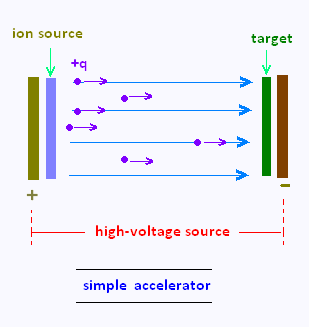Nuclear Physics
The nucleus
Radioactivity
Applications
Particle accelerators
© The scientific sentence. 2010
|
Nuclear Physics &
Particle Physics
Particle accelerators
Electrostatic Accelerators
Van de Graaff Accelerator
Electrostatic Accelerators

An electrostatic accelerators work by accelerating a charged particle
through a constant potential difference.
If a particle has a charge q and mass m and move through a potential difference of
V then it will gain a kinetic energy of:
mv2/2 = qV
The electrostatic accelerators use of electric fields to accelerate charged particles. They
varies widely in the manner in which the fields are applied. The most straightforward type
of accelerator results from the application of a potential difference between two terminals.
(see the figure)
The first particle accelerator was built by two physicists, Ernest Walton
(1903-1995) and John Cockcroft (1897-1967) and used the principle of
electrostatic acceleration.
|
|